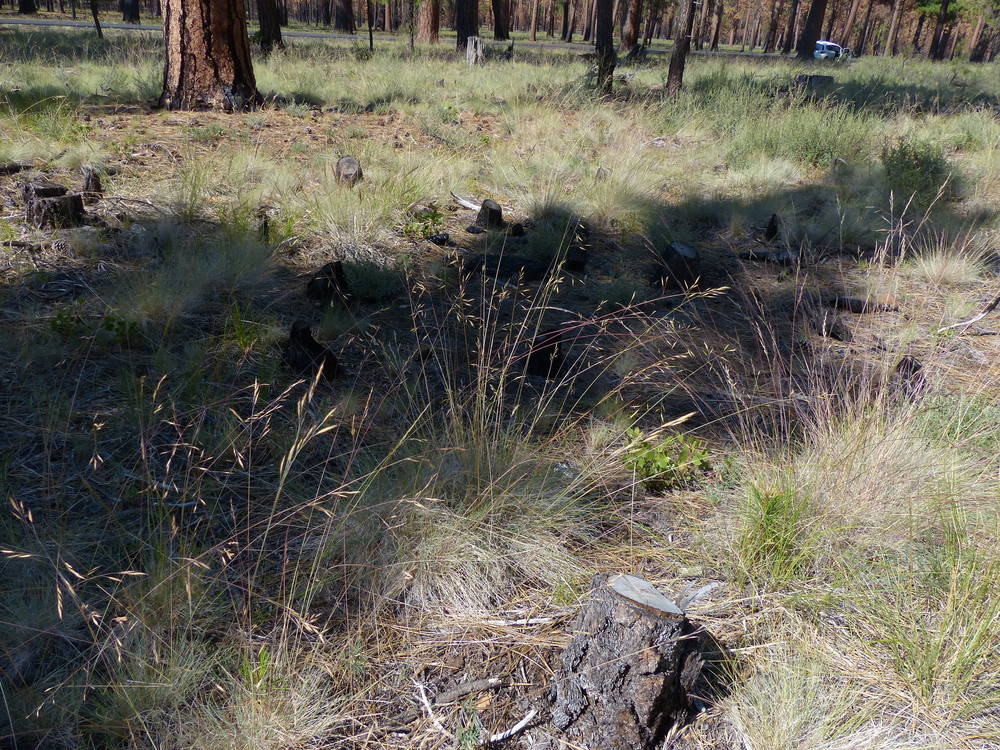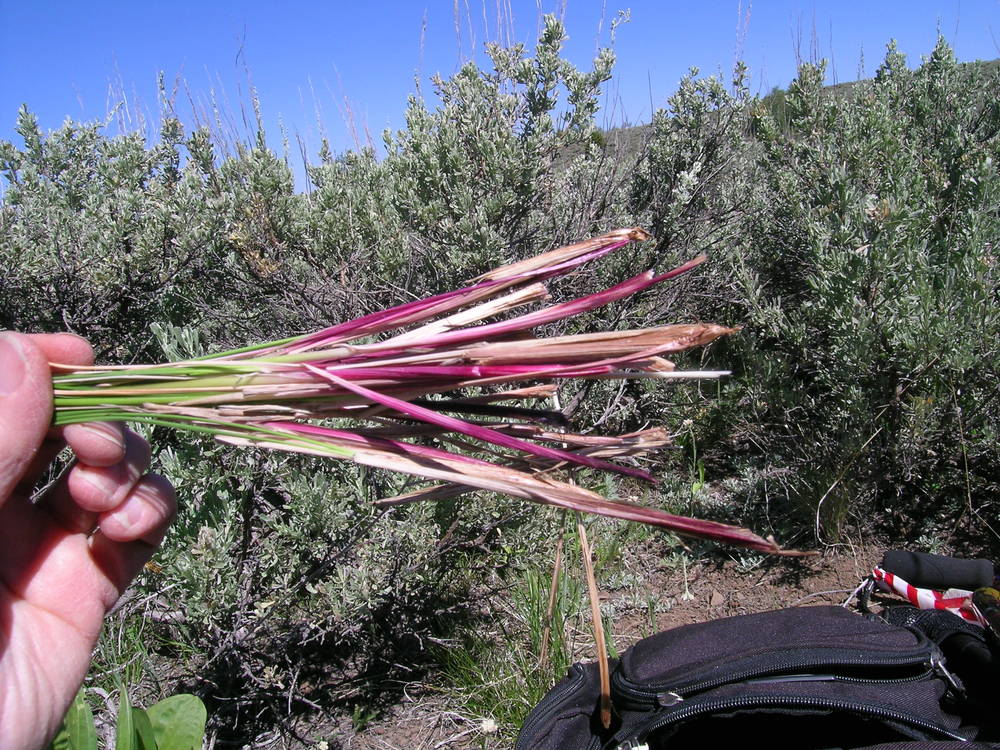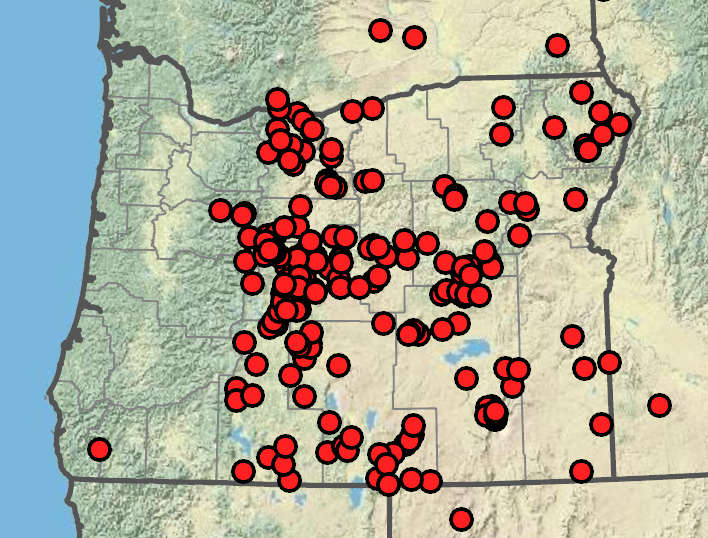Festuca idahoensis
Festuca campestris
Idaho fescue
mountain rough fescue
basal branching intravaginal.
with nodes hidden.
mostly basal;
sheaths open, glabrous to hairy, usually pale (white, pink, light brown) and lacking contrasting veins, crumbling or somewhat splitting between the veins but not shredding;
blades readily spinning between the fingers;
collars glabrous;
ligules 0.3–0.6 mm;
blades (5)8– 25(35)cm × 0.3–1 mm as folded, conduplicate, usually glaucous, sometimes green;
outer surface scabrous, sometimes with long hairs;
inner surface with hairs about as long as the leaf is thick; flag leaves (1.5)3–7(9.5) cm, usually conduplicate, sometimes loosely rolled.
mainly basal;
sheaths pale, glabrous, papillose, conspicuous at the base of the plant and persisting for more than 1 year; entire, forming a dense tuft of split tubes at the base of the plant;
collars glabrous;
ligules 0.1–0.5 mm;
blades 0.5–1.1 mm wide when tightly folded, 1.6–2.5(3)mm wide when flat or loosely rolled; somewhat stiff;
outer surface papillose;
inner surface with long hairs; flag leaves 2.5–7.5 cm.
s (5)7– 12(20) cm; open at anthesis; lowest node with 1–2 branches;
branches (5.8)7.5–17(19)mm, ascending to reflexed at anthesis, appressed after anthesis or the lower branches sometimes remaining spreading to reflexed.
5–18 cm; lowest node with 1–3 spreading branches 2.5–7(13)cm.
(5.8)7.5–17(19)mm, with (2)3–7(9) florets.
8–12(16) × 2.5–7 mm, with (3)4–5(7) florets.
glabrous or hairy at the tips only;
lower glumes (2.5)3–5(6)mm, 1–3-veined;
upper glumes (3)4–8 mm, 3–4-veined.
glabrous or scabrous at the tips;
lower glumes 4.5–7.5(8.5)mm, 1(3)-veined;
upper glumes 5.3–8.2(9) mm; (1)3-veined.
4–4.5 mm, glabrous.
3.5–4.5 mm; hairy at the tip.
apex glabrous.
apex hairy.
cross sections 0.35–0.6 × 0.55– 0.7 mm; more or less round or hexagonal;
veins (4)5(6);
ribs (1)3(5); dorsal sclerenchyma in broad bands more than twice as wide as thick, occasionally continuous.
(5.8)6–8(10)mm, 0(1)-veined;
hairs on the distal part only;
lemma awns (1)2–6(7) mm; shorter than to occasionally equaling the lemma body.
(6.2)7– 8.5(10)mm; (0)5-veined, slightly scabrous throughout, rarely glabrous;
lemma awns 0.5–1.5 mm.
(2.5)3.2–4(4.5) mm.
(3.3)4.5–6 mm.
=28.
Festuca idahoensis
Festuca campestris
Prairie, grassland, shrub-steppe, open pine forest, often in partial shade or on north-facing slopes; also on south-facing slopes in subalpine and alpine zones. 100–3000 m. BR, BW, Casc, Col, ECas, Lava, Owy. CA, ID, NV, WA; north to British Columbia, northeast to Saskatchewan, SD, and NM. Native.
Festuca idahoensis is the most common fine-leaved fescue east of the Cascades. However, very similar fescues have been introduced. Festuca trachyphylla and F. valesiaca, planted on roadsides and used to renovate dry pastures, have shorter lemmas and denser inflorescences. Robust individuals of F. occidentalis can be similar to F. idahoensis, but in F. occidentalis many of the lemma awns are longer than the lemmas. In alpine sites, F. idahoensis can be confused with F. brachyphylla and F. saximontana, which have shorter lemmas. Plants west of the crest of the Cascades that were once included in F. idahoensis are now recognized as a distinct species, F. roemeri, which has broader leaves than F. idahoensis.
Dry grassland, sage-steppe. 600–3000m. BR, BW. ID, WA; north to British Columbia, northeast to Saskatchewan and MT. Native.
The leaves of Festuca campestris are stiffer and more papillose than those of similar F. idahoensis or Achnatherum species. Festuca campestris is part of what was once called F. scabrella, which has been divided into three taxa: F. altaica (central Asia and North America south to British Columbia and Alberta), F. hallii (northern Great Plains), and F. campestris.
Barbara Wilson, Richard Brainerd, Nick Otting
Barbara Wilson, Richard Brainerd, Nick Otting
- Local floras:
BC,
CA,
OR,
WA
- Local Web sites:
CalFlora,
CalPhotos,
Flora NW,
PNW Herbaria
WildflowerSearch
iNaturalist (observations)
USDA Plants Database
- LBJ Wildflower Center
- SEINet
- Plants of the World Online
- Encyclopedia of Life
- Wikipedia
- Google Image Search
- Local floras:
BC,
OR,
WA
- Local Web sites:
Flora NW,
PNW Herbaria
WildflowerSearch
iNaturalist (observations)
USDA Plants Database
- LBJ Wildflower Center
- SEINet
- Plants of the World Online
- Encyclopedia of Life
- Wikipedia
- Google Image Search





